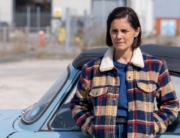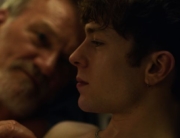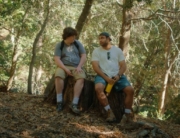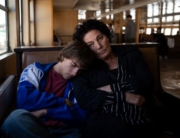French writer-director Christophe Honoré has been making solid films for the past three decades, including Love Songs. His latest is no exception to his building repertoire. Set in 1993, it follows two gay men at different stages of their lives. On the surface, it’s a love story, but Honoré’ has also made a requiem to a time in gay culture that has passed.
Arthur (Vincent Lacoste), a 22-year-old college student from Brittany, is wayward in a lot of ways. At one point, he says he’s been in school so long he has forgotten what it was he was studying. Despite being openly bisexual to his girlfriend, he is pretty much unresponsive to her sexual advances, and at night, he takes strolls to darkened parking lots in search of anonymous gay trysts.
The main character, though, is Jacques, played by Pierre Deladonchamps, who some will recognize from the 2013 French murder mystery Stranger by the Lake. At 35, Jacques is a respectable author and playwright who is probably on his way to becoming a household name, but he’s had to put all of his life’s prospects on hold since his HIV diagnosis. As he realizes he may be near the end (this is before the availability of current medications), Jacques takes inventory of his life.
He doesn’t having a life partner, but he does have a son with whom he is very close. He shares custody with his best female friend, and he also has a best gay friend, Mathieu (Denis Podalyde?s), who lives in the apartment below him and whom he can depend on for anything. As we meet one of his exes, Marco, who is dying of AIDS, we get the impression Jacques has never found “the one,” though it is alluded that he has had several significant long-term relationships. Attractive as he is, he’s never failed at finding men to hook up with, but he’s also intimidatingly well-read and perhaps just a tad bit too much of a prima donna to have lived happily ever after with someone.
The two main characters, both of whom are quite good at the gay pastime of cruising, become attuned to each other’s signals from across a darkened movie theater. Jacques, who is in the Breton city of Rennes for a production of one of his plays, lets Arthur show him around the town, and the two end up staying up all night together. After Jacques goes back to Paris, the two stay in contact through letters, postcards, and extended phone chats. Although there are many sex scenes, they are always clipped, either stopping at the beginning or coming in just at the end.
Though the film is very dialogue-driven and verbose, it never becomes tedious. One particularly rewatchable scene is when, over the phone, the elder imparts his scholarly wisdom on the type of men some gay literary figures (Allen Ginsburg, W.H. Auden, and Christopher Isherwood) had taxonomized as different types of “blonds”—who aren’t blonds per se. It’s a catchall for the different types of attractive men one encounters and what to expect, such as the “Whitman,” a man who has slept with everyone, which is a reference to Ginsberg’s claim that he traced his lover’s lovers all the way back to Walt Whitman.
This taxonomy of “blonds” emerges as a central theme. Honoré’s film is populated by so many men, most of them in their 20s and stunningly photogenic. There are scant few female supporting characters. They merely come and go while the film stays focused on different levels of relationships between men. Even the mother of Jacques’s child is only given a handful of scenes, and she isn’t fleshed out. So, the film takes us into a world primarily composed of men, whether they are gay, bi, straight, young, or old. By focusing so much on these men in the background and foreground, the film develops a gay male gaze for the viewer to learn how Jacques and Arthur see the world, take in all the men they encounter in everyday life, and gauge what type of “blond” each could turn out to be.
In the waiting room of an AIDS clinic, Jacques takes out a disposable camera and snaps a shot of an attractive young man who is completely unaware of him. While this is definitely creepy, another man about Jacques’s age smiles at the writer in a way that suggests he understands exactly what the photographer is doing. Whereas Jacques might normally make a pass at the young man, he instead captures a photo of him. Throughout the film, Jacques comes to grips with what he’s up against. His snapshot of the young man in the clinic is emblematic of exactly what Honoré’s film set out to do, to write a melancholic love letter to the gay ‘90s.

















Leave A Comment